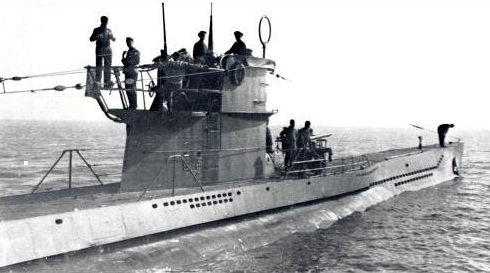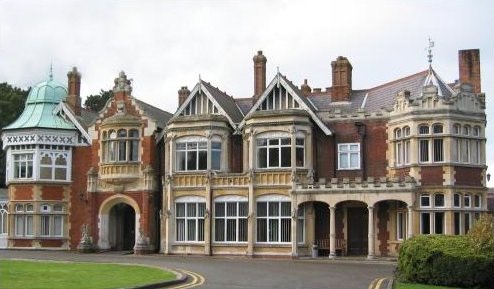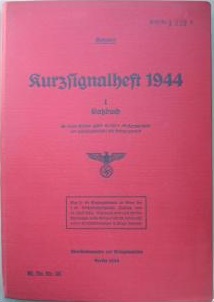|

German Type VII U-boat |
However, after the invasion of Poland, Britain declared the war to Germany on 3 September 1939, and the Royal Navy had almost ten times more warships than the Kriegsmarine. After the loss of several German war ships and having the destruction of Allied convoys to Britain as a new priority, the Kriegsmarine was forced to adapt their naval tactics.
The production of U-boats increased rapidly and Dönitz was finally able to apply his new strategy, the Rudel Taktik or wolf-pack tactics. The German Kriegsmarine proved to be very successful with their Wolf-pack technique. U-boats hunted individually for convoys. If a convoy was spotted, they did not attack but shadowed their prey and sent a contact message to U-boat command, which in turn sent a message to multiple other U-boats to coordinate an attack.
Once all U-boats on the spot, they sunk the convoy with a closely coordinated attack. This technique was so devastating that it could have decided the outcome of war in favor of Germany. The Allies lost their ships faster than they could build new ones to replace them. Communication was the key to the success of the Wolf-packs, and the Kriegsmarine used Enigma to encipher their messages.
Hunting the Shark
The Allied Forces faced the impossible task to get control over the vast Atlantic Ocean. Surprisingly, the Kriegsmarine offered them the solution to this problem. In Bletchley Park, England, a team of codebreaker was breaking into the German Wehrmacht, Luftwaffe and Kriegsmarine communications. All information, retrieved from decrypted messages, was codenamed ULTRA. Many different sections worked in Bletchley Park on different ciphers and codes of the German armed forces. Each section was designated by the barracks or Huts where they worked in. Hugh Alexander and Alan Turing led the attack on the naval Enigma encryption in Hut 8.
At the start of war, the U-boat communication network used the three-rotor Enigma M3 to encipher their messages. The M3 was identical to the Wehrmacht and Luftwaffe Enigma but the Kriegsmarine had a set of eight rotors to choose from, instead of the normal set of five. Initially, the main keys to encrypt Enigma messages on U-boats and surface ships in the home waters and the Atlantic were codenamed HEIMISCHE GEWÄSSER with its own Enigam key sheets. This key, designated Dolphin by Bletchley Park, was the most important one, although many other keys were operational on different naval locations. Despite the British Navy having recovered two of the three additional naval rotors from U-33 early in 1940 and the third rotor in August of the same year, Bletchley could still not break the Dolphin keys.
To break Dolphin, they had to know the daily changing rotor combinations that were used. One way to find out these combinations was the use of cribs. Cribs were little pieces of assumed text. Once the codebreakers located a crib in an Enigma message (there were techniques for that) the associations between the letters of the encrypted text and its plain non-encrypted version were entered in a Turing Bombe. This machine, designed by Alan Turing and Gordon Welchman, contained a large number of drums, each replicating the rotors of the Enigma, and ran through all possible settings to find the key settings that belong to the combination of a given piece of cipher and plain text. Once these settings were found they could decipher all messages of that particular day. Unfortunately, few cribs were available the until summer of 1941.
Another important setting of the Enigma machine that had to be found was the initial rotor positions at the beginning of enciphering, called the message key. The Kriegsmarine message procedures were far more complex than those used by the Wehrmacht and Luftwaffe. The Kriegsmarine messages keys were selected from special codebooks and different message key system, key sheets and codebooks existed for normal messages, Kurzsignalen (short-signals) and weather reports. Except for some brief periods, Bletchley was unable to get grip on the complex naval keys. More about the message procedures on this page.
Dolphin Broken

Bletchley Park
England |
A breakthrough occurred when several codebooks were secretly captured. On 9 May 1941, a Kurzsignal (short-signal) codebook was recovered during the boarding of Kapitänleutnant Lemp's U-110. This codebook proved to be important to develop new methods to attack Dolphin.
However, attacking and boarding U-boats was a risky operation, especially because the operation had to be kept secret. Harry Hinsley, one of the Bletchley codebreakers, discovered that the same codebooks that were used on heavily armed U-boats were also being used aboard unprotected German trawlers, operating as weather ships for the Kriegsmarine.
On 7 May 1941 HMS Somali boarded the weather ship München southeast of Iceland. Weather ship Lauenburg was attacked and boarded on 28 June in the Arctic Ocean by HMS Nigeria, together with HMS Tartar, HMS Bedouin and HMS Jupiter. Both the München and Lauenburg were sunk after a boarding party recovered the Wetterkurzschlüssel (weather short-signal) codebooks. The Kriegsmarine presumed both ships lost at sea.
Meanwhile, the weather section in Hut 10 broke the manual cipher that was used for meteorological reports within the Kriegsmarine. These reports originated from the U-boats and were sent by them as Wetterkurzsignalen (weather short-signals). The U-boats first encoded these reports with the WetterKurzschlüssel before encrypting them with Enigma. A Wetterkurzsignal consisted of a fixed number of letters, each letter representing a specific weather condition or value. However, having the decrypted meteorological reports and knowing into which codes they were converted, Bletchley could now guess the plain text letters in the original with Enigma encrypted Wetterkurzsignal from the U-boat. This well-thought detour provided good cribs to attack Dolphin.
Sometimes, due to lack of cribs, Bletchley Park used a technique called Gardening. British bombers dropped or planted series of sea mines on well determined places. German U-boats, spotting these mines, transmitted contact messages. Messages about these mines and about cleared sea-lines were often send by both Enigma and a manual cipher called Werftschlüssel (shipyard key). After Bletchley Park broke the Werftschlüssel, they again had a plain text version and Enigma enciphered version of that text, providing them with new cribs for their Bombes. Bletchley Park was now constantly breaking the U-boat messages and knew their battle orders and locations. This enabled the Admiralty to re-route Allied convoys. Things were looking good...
TRITON Strikes Back
The dropping results made Admiral Dönitz suspicious. Although reassured by the Abwehr, the German Foreign Intelligence, that Enigma was unbreakable, he insisted on improving the security of Enigma. On 1 February 1942 the famous Enigma M4 model with four rotors and new key sheets were introduced. The new and more complicated TRITON, designated Shark by Bletchley Park, caused a complete black-out. They could no longer break the U-boat radio traffic and no longer had any idea of the U-boat positions. On top of that, new Wetterkurzschlüssel codebooks were introduced one month earlier. This deprived Bletchley Park completely of any cribs. The Kriegsmarine called the springtime of 1942 Die Glücklichen Zeiten or Happy Times, because of the enormous shipload they sunk. Note that the propaganda term Happy Times is relative, taken in account the dangerous and extreme circumstances the U-boat crews were operating in.
After ten nerve wrecking months of heavy losses, Bletchley Park succeeded in breaking into SHARK. This was due to several different reasons. An important event was the attack on Kapitänleutnant Hans Heidtmann's U-559 by the British destroyer HMS Petard on 30 October 1942. After taking heavy fire from HMS Petard, the sinking U-boat was boarded by three British sailors. They managed to get the Enigma key sheets and the new edition of the Wetterkurzschlüssel code. Two of them returned once more to recover the Enigma M4 but went down with the U-boat. They paid their bravery with their live, but not without result. This mission proved to be a turning point in breaking SHARK. On 13 December 1942, more than ten months after the start of the black-out, Bletchley Park could finally inform the Admiralty again about U-boats positions.
After breaking a substantial number of messages, the codebreakers realized that the U-boat weather reports, encoded with the WetterKurzschlüssel, were sent with the four-rotor Enigma in the less complicated M3 mode (the fourth rotor in A position with ring setting A). This was done to be compatible with the three-rotor Enigma M3, used on weather ships. The Bombes in Bletchley Park, developed to crack the three-rotor Enigma, took more than 20 days to crack the four-rotor Enigma key settings. However, a three-rotor key setting could be retrieved in less than 24 hours.
This discovery was an enormous time profit. With the broken meteorological reports from Hut 10 and the recovered Wetterkurzschlüssel they finally broke TRITON continuously. When a new edition of the Wetterkurzschlüssel came into service in March 1943, the seized U-559 Wetterkurzschlüssel became useless, resulting in a new black-out. Fortunately, the Kurzsignalheft code book, also recovered from U-559, provided new ways to find cribs in U-boat short-signals and enabled the codebreakers to re-enter SHARK after nine days. Except for some brief periods, the codebreakers never lost SHARK again.
Kurzsignale Fail

Kurzsignalheft |
The U-boats used the Kurzsignalheft (short-signal book) to encipher contact messages. The Kriegsmarine converted default tactical expressions with a code table, called Kurzsignalheft, before enciphering them with Enigma. A contact with a convoy could for example be converted into UGKU, an enemy airplane into HKJL, or a meeting point for refueling into KLUG. More about these short-signals on Kurzsignale on German U-boats.
The use of Kurzsignale seemed to be a clever choice. It was harder for Allied Signal Intelligence to trace these short messages with HDFD (High Frequency Direction Finding or Huffduff). Moreover, attempts to decipher these short messages didn't give any readable sentences, and approaching the correct key did not reveal pieces of normal sentences, helping to find the key settings. Also, the conversion of text into four letter codes shortened the cipher text. Less cipher text also provides less statistics to the codebreakers. Nothing but advantages...they believed.
Unfortunately for the Germans, the use of Kurzsignale resulted into recognizable patterns in the Enigma messages. A convoy, nearing a U-boat, would probably evoke a contact message. An airplane, spotting a U-boat, would result in an airplane contact message. In Bletchley Park, tactical information was linked to positions, obtained by HFDF and reconnaissance reports, to find out what type of message was sent by that particular U-boat.
In combination with the recovered Kurzsignalheft codebook, Bletchley Park was able to predict the content of the enciphered messages, thus providing them again with crucial cribs to feed into their Bombes. Meanwhile, new Bombes were developed to deal with the four-rotor Enigma. By June 1943, the first four-rotor Bombes came into action, and by the end of 1943 another fifty four-rotor Bombes went operational at OP-20-G, the American Naval codebreakers. In the fall of 1943, SHARK messages were generally broken within 24 hours.
U-boats Down
The ULTRA information was extremely effective in the strategically very important North Atlantic Ocean. After the initial hard times, Bletchley Park broke the Enigma messages on a daily base. The tide of U-boat war was turned. Except for some brief periods, the entire German communication system was intercepted by a large number of listening stations called Y-stations, and the ciphers and codes broken in Bletchley Park, with over 7000 employees at its peak. With the positions of the U-boats unveiled, Allied ships were simply re-routed to avoid fatal confrontations with the U-boats, and an active hunt for the U-boats begun.
The elite weapon of the Kriegsmarine became decimated, resulting in heavy losses among the U-boat crews. An estimated 700 U-boats and 30,000 crewmen were lost at sea. The German command related these losses to new detection techniques like the ASDIC sonar system, U-boat detection planes, and destroyers escorting convoys. This was partially a correct assumption, but they never suspected cryptanalysis of their Enigma encrypted radio traffic. The Enigma machine could undoubtedly provide a for those days unbreakable encryption. However, unsafe procedures and tactical mistakes turned the Enigma machine into the Achilles heel of the German war machine. Germany kept on using Enigma without any suspicion in all parts of their forces, which resulted in catastrophic consequences for Nazi Germany.
Reality vs Fiction
Some books and movies, like Jonathan Mostow's "U-571" (fiction 2000) wrongly suggest the codebreakers were helped by captured Enigma machines. British and French Intelligence already received three-rotor Enigma replicas from Polish Secret Service, as early as 1939. In reality, the four-rotor Enigma and its internal wiring was obtained by cryptanalysis on intercepted messages and captured codebooks. The breakthrough in SHARK was established without possessing an actual M4 Enigma. The secret and infamous U-boat and weather ship boardings were performed by the British Navy, and their primary goal was to capture the Kurzsignale, Wetterkurzschlüssel and Enigma key sheets, and not to seize an Enigma machine. Although "Enigma" (fiction 2002), from Michael Apted with Dougray Scott and Kate Winslet is also historical incorrect, it gives a better technical view on the attempts to break into TRITON and how they worked in Bletchley Park.
More about Enigma on this site 
- Enigma History
- Enigma Codebooks and Message Procedures
- Technical Details on the Enigma
- Kurzsignale (Short Signals) on German U-boats
- Break an original M4 message and the story of U-264
- Enigma Cipher Challenge
- Enigma FAQ page
- Enigma Simulator
- Enigma Codebook Tool
- References
More on Enigma and U-boats (offsite - opens in new tab)
- The Enigma and the Bombe Naval Enigma, Graham Ellsbury
- Breaking Naval Enigma on U-boat Net
- Breaking Naval
Enigma Dolphin and Shark
 by Ralph Erskine
by Ralph Erskine - Ultra and the Battle of the Atlantic from NSA archives on ibiblio.org
- U-Boats communications and HF DF from NSA archives on ibiblio.org
- Mac's AHOY website Naval warfare in the Second World War
- The boarding of weatherships Lauenburg and Munchen at Warcovers
- The capture of U-110 by HMS Bulldog and HMS Broadway
© Dirk Rijmenants 2004. Last changes: 21
December 2023
| Home Enigma |